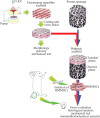Current State of Cartilage Tissue Engineering using Nanofibrous Scaffolds and Stem Cells
- PMID: 28496944
- PMCID: PMC5410130
Current State of Cartilage Tissue Engineering using Nanofibrous Scaffolds and Stem Cells
Abstract
Cartilage is an avascular, aneural, and alymphatic connective tissue with a limited capacity caused by low mitotic activity of its resident cells, chondrocytes. Natural repair of full thickness cartilage defects usually leads to the formation of fibrocartilage with lower function and mechanical force compared with the original hyaline cartilage and further deterioration can occur. Tissue engineering and regenerative medicine is a promising strategy to repair bone and articular cartilage defects and rehabilitate joint functions by focusing on the optimal combination of cells, material scaffolds, and signaling molecules. The unique physical and topographical properties of nanofibrous structures allow them to mimic the extracellular matrix of native cartilage, making an appropriate resemblance to induce cartilage tissue regeneration and reconstruction. To improve simulation of native cartilage, the incorporation of nanofibrous scaffolds with suitable corresponsive cells could be effective. In this review article, an attempt was made to present the current state of cartilage tissue engineering using nanofibrous scaffolds and stem cells as high proliferative immune privilege cells with chondrogenic differentiation ability. The comprehensive information was retrieved by search of relevant subject headings in Medline/Pubmed and Elsevier databases.
Keywords: Cartilage; Nanofibers; Scaffolds; Stem cells; Tissue engineering.
Figures



Similar articles
-
Suppressing mesenchymal stem cell hypertrophy and endochondral ossification in 3D cartilage regeneration with nanofibrous poly(l-lactic acid) scaffold and matrilin-3.Acta Biomater. 2018 Aug;76:29-38. doi: 10.1016/j.actbio.2018.06.027. Epub 2018 Jun 22. Acta Biomater. 2018. PMID: 29940371 Free PMC article.
-
Pore size directs bone marrow stromal cell fate and tissue regeneration in nanofibrous macroporous scaffolds by mediating vascularization.Acta Biomater. 2018 Dec;82:1-11. doi: 10.1016/j.actbio.2018.10.016. Epub 2018 Oct 13. Acta Biomater. 2018. PMID: 30321630 Free PMC article.
-
Enhanced chondrogenic differentiation of stem cells using an optimized electrospun nanofibrous PLLA/PEG scaffolds loaded with glucosamine.J Biomed Mater Res A. 2017 Sep;105(9):2461-2474. doi: 10.1002/jbm.a.36104. Epub 2017 Jun 6. J Biomed Mater Res A. 2017. PMID: 28481047
-
A Comprehensive Review of Stem Cells for Cartilage Regeneration in Osteoarthritis.Adv Exp Med Biol. 2018;1089:23-36. doi: 10.1007/5584_2018_205. Adv Exp Med Biol. 2018. PMID: 29725971 Review.
-
Advances in electrospun nanofibers for bone and cartilage regeneration.J Nanosci Nanotechnol. 2013 Jul;13(7):4656-71. doi: 10.1166/jnn.2013.7186. J Nanosci Nanotechnol. 2013. PMID: 23901488 Review.
Cited by
-
Mitochondria in Injury, Inflammation and Disease of Articular Skeletal Joints.Front Immunol. 2021 Sep 3;12:695257. doi: 10.3389/fimmu.2021.695257. eCollection 2021. Front Immunol. 2021. PMID: 34539627 Free PMC article. Review.
-
A review of in-vitro fibrocartilage tissue engineered therapies with a focus on the temporomandibular joint.Arch Oral Biol. 2017 Nov;83:193-201. doi: 10.1016/j.archoralbio.2017.07.013. Epub 2017 Jul 23. Arch Oral Biol. 2017. PMID: 28787640 Free PMC article. Review.
-
Extracellular Nucleotides Selectively Induce Migration of Chondrocytes and Expression of Type II Collagen.Int J Mol Sci. 2020 Jul 23;21(15):5227. doi: 10.3390/ijms21155227. Int J Mol Sci. 2020. PMID: 32718031 Free PMC article.
-
Repair of Osteochondral Defects in Rabbit Knee Using Menstrual Blood Stem Cells Encapsulated in Fibrin Glue: A Good Stem Cell Candidate for the Treatment of Osteochondral Defects.Tissue Eng Regen Med. 2019 Apr 27;16(3):311-324. doi: 10.1007/s13770-019-00189-9. eCollection 2019 Jun. Tissue Eng Regen Med. 2019. PMID: 31205859 Free PMC article.
-
Nanofiber scaffolds based on extracellular matrix for articular cartilage engineering: A perspective.Nanotheranostics. 2023 Jan 1;7(1):61-69. doi: 10.7150/ntno.78611. eCollection 2023. Nanotheranostics. 2023. PMID: 36593799 Free PMC article. Review.
References
-
- Filová E, Rampichová M, Litvinec A, Držík M, Míčková A, Buzgo M, et al. A cell-free nanofiber composite scaffold regenerated osteochondral defects in miniature pigs. Inte J Pharm 2013;447(1–2):139–149. - PubMed
-
- Zhang S, Chen L, Jiang Y, Cai Y, Xu G, Tong T, et al. Bi-layer collagen/microporous electrospun nanofiber scaffold improves the osteochondral regeneration. Acta Biomater 2013;9(7):7236–7247. - PubMed
-
- Shafiee A, Soleimani M, Chamheidari GA, Seyedjafari E, Dodel M, Atashi A, et al. Electrospun nanofiber-based regeneration of cartilage enhanced by mesenchymal stem cells. J Biomed Mater Res A 2011;99(3):467–478. - PubMed
-
- Chiang H, Jiang CC. Repair of articular cartilage defects: review and perspectives. J Formos Med Assoc 2009;108 (2):87–101. - PubMed
-
- Koga H, Engebretsen L, Brinchmann JE, Muneta T, Sekiya I. Mesenchymal stem cell-based therapy for cartilage repair: a review. Knee Surg Sports Traumatol Arthrosc 2009;17(11):1289–1297. - PubMed
Publication types
LinkOut - more resources
Full Text Sources
